Impact of AI on Security and Surveillance on Smart City Quality of Life
 By Anolytics | 04 March, 2022 in AI in Security | 3 mins read
By Anolytics | 04 March, 2022 in AI in Security | 3 mins read

As more cities adopt monitoring and sensing technology, artificial intelligence-enabled ai in security cameras are on the front lines of data collection in traffic, policing, and health and safety. However, there are no widely acknowledged norms for utilizing the data generated by these technologies, raising worries about government surveillance, mainly as AI and analytics applied to video grow more ubiquitous.
Camera enhancements, artificial intelligence, and machine language processing may improve public safety and transportation advantages. Still, they also create complex intellectual property, privacy, and civil responsibility, among other things.
According to a published study, by 2025, there will be at least 26 eligible global intelligent cities, nine of which will be in the United States. Thanks to artificial intelligence and machine learning advances, every infrastructure will need to adapt to suit an intellectual environment as our cities grow more technologically savvy.
The volume and capabilities of video are being combined with deep learning-powered video analytics in a new generation of AI applications. These AI-enabled solutions improve operational efficiency and safety in a variety of settings, including roadways, toll booths, and parking lots.
AI in Security Video Surveillance
From satellite street and traffic cameras that increase operational efficiency to stoplight cameras that protect civilian safety, AI video surveillance has emerged as a vital aspect of boosting public safety and efficiency as we know and love the shift to being smart.
Smart cities use video data to improve people’s quality of life, municipal operations, and, of course, environmental security. Cities require a simple method of assessing the effectiveness of public infrastructure, transit services, and the urban environment. While the importance of AI security cameras system is obvious, many communities are unable to reap the benefits of their investment because they lack the means to exploit the massive amounts of video data acquired.
The ability to quickly review large amounts of video, gain a complete understanding of the scene, analyze both moving items and background, classify objects, investigate interrelations between objects, classify object behavior, and generate statistical data is a real competitive advantage for Smart Cities.
AI security cameras, which police and transportation agencies in cities routinely employ, may be part of the “smart” technology suite – mainly if the cities apply video analytics software to extract operational intelligence from the footage.
Although video provides a multitude of helpful information, much of it is never evaluated. Even if it is, human analysts can rarely grasp or analyze all of the data included within it.
Video analytics technology tackles this challenge by analyzing video data and recognizing, categorizing, and indexing items in video footage such as automobiles, trucks, buses, motorbikes, bicycles, women, men, children, and animals. Such software, powered by Deep Learning and Artificial Intelligence, makes video searchable, actionable, and measurable.
How It Works AI in security
Machine Learning and Deep Learning algorithms are used in surveillance video analytics to recognize distinct sorts of objects, categorize them, and determine their attributes. When we hear something new and unique, we try to understand it by comparing it to comparable information. This comparison approach is similar to that used by Machine Learning and Deep Learning algorithms.
Machine and deep neural networks are trained differently in order to discern what is a known item. Machine Learning involves more than simply a programmer’s human input to establish the parameters necessary to get the desired result. Deep Learning can detect object traits without the help of programmers, and it may be able to spot features that programmers overlook.
Training datasets for Security and Surveillance
Machine Learning (ML) is increasingly becoming a crucial part of our daily life. AI is present in every industry we work in. Computers can learn without being explicitly programmed, thanks to machine learning. To put it another way, machine learning trains machines through training datasets to learn the same way humans do: via experience.
We deliver training datasets for security and surveillance. Anolytics provide a diverse variety of training datasets for AI models created for AI security cameras.
Conclusion
Most cities already have surveillance cameras systems; Smart Cities are now applying AI-enabled security cameras to maximize their current investment in their CCTV networks and promote intelligent decision-making. Because different businesses can extract benefits from video data, which they can utilize in their attempts to raise efficiency, simplify operations, and promote public health and safety, it’s a logical and cost-effective solution.
please contact our expert.
Talk to an Expert →
You might be interested

- AI in Security 20 Jun, 2020
How to Improve AI Security Camera Performance with Image Annotation?
The use of security cameras in home security and round-the-clock surveillance become more popular among people globally.
Read More →
- AI in Security 15 Apr, 2021
How AI in Security Cameras Provide best Security Surveillance Solutions?
Public security and surveillance is becoming more important with the increase of crime and threats from illegal activiti
Read More →
- AI in Security 08 Oct, 2023
Security in the future at drone-enabled construction sites
Businesses, the world over are introducing some major transformations in operational capacities and deliveries and are g
Read More →